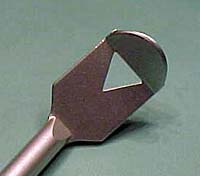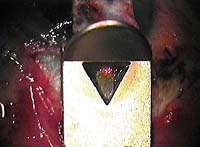Surgeon: Use of excimer laser in deep sclerectomy adds precision and safety
The excimer laser ablates gradually into the sclera and stops as soon as the aqueous percolates through.
VENICE, Italy — The use of the excimer laser in deep sclerectomy adds precision and safety to the procedure, according to Luigi Olivieri, MD, who spoke at the Venice 2000 meeting here.
“The most crucial and, at the same time, the most risky step of deep sclerectomy is the performance of the second scleral flap. It takes skill and experience to cut it so that it is not too deep or too shallow,” Dr. Olivieri said.
Data reported by the surgeon showed an average 10% to 20% of cases where dissection was too superficial, with consequent insufficient filtration, and an average 5% to 10% of cases where the cut was performed too deeply into the sclera, producing ciliary bleeding and iris prolapse.
“The excimer laser is an excellent means for detecting the exact point as to where to stop,” he said. “The laser beam penetrates gradually into the sclera until the aqueous humor percolates from Descemet’s membrane. At that point, you know that you have reached your finishing line, because the excimer laser loses its ablation power in the presence of water.” The risk of too deep a perforation is thus avoided. The ablation can then be deepened to the desired level by drying the tissue with a surgical sponge and gradually proceeding in thin, progressive layers.
Dr. Olivieri and his colleagues, Italo Cantera, MD, and Vincenzo Ramovecchi, MD, have been using this technique for about a year in their surgery in their practices.
Masking device
For better definition of the ablation area, the two surgeons use a small device of their own invention. It is a small spatula (Meditekno, Rome) with a round, uplifted tip and a triangular hole in the center. The dimensions of the triangle replicate those of the hyaluronic acid implant that is inserted at a later stage of the operation (3.5 × 3.5 mm/3 × 4.5 mm).
“Thanks to our device, we can obtain an ablation that is a perfect container for the implant. The laser ablates within the area of the triangular-shaped hole, while the remainder of the spatula protects the surrounding tissues,” Dr. Olivieri said.
The masking device is first used as a marker for the first scleral flap. The spatula is applied on the conjunctiva with a gentle pressure and, once it has been lifted, a gauged 300 mm knife is used to cut a 4 × 4 flap along the triangular trace.
Once the superficial flap is opened, the spatula is positioned inside. The base is firmly anchored to the underlying sclera by three small protrusions, and the uplifted vertex protects and keeps in position the overturned scleral flap. The triangular-shaped hole in the center exposes a portion of scleral tissue.
A controlled ablation
 |
 |
| The masking device, a small spatula with a round, uplifted tip and a triangular hole in the center (figure 1), is first used as a marker for the first scleral flap. Then it is used to protect the surrounding tissue as the laser ablates the uncovered triangular area (figure 2). | |
The laser gradually ablates the tissue of the uncovered area. “The action of the laser is gentle and non-traumatic,” Dr. Olivieri said. “You can slowly see the creamy white color of the sclera turning gray while approximating the trabeculum and the choroid. When the aqueous humor starts percolating through, the action of the laser breaks off. The ablation is taken a few steps further by drying the liquid until a copious, regular outflow indicates that Schlemm’s canal is well opened and that the aqueous filtrates easily through the trabeculum.”
A drainage implant is then inserted in its made-to-measure site, and the scleral flap is stitched with nylon sutures. Drs. Olivieri, Cantera and Ramovecchi use 3.5 × 3.5 cross-linked hyaluronic acid SKGel implants (Corneal, Paris).
The lasers they use are the Bausch & Lomb (Claremont, U.S.A.) Technolas 217 and the Summit (Waltham, U.S.A.) SVS Apex Plus set at 4,500 and 400 spots, respectively. They say that both have given equally good results.
“Our results are encouraging, and we had no complications. The combination of the laser and the masking device allows a constant control of the dissection planes, and makes you feel safe and confident,” Dr. Olivieri said. However, he pointed out that “the laser optics should be improved and adapted to the technique, as they are not originally designed for this type of surgery. In particular, we should be able to improve the quality and control of the ablation in the area of Schlemm’s canal to make certain that it is properly unroofed and that the ablation stops at the most appropriate time.”
The eight patients treated with this method have a medium follow-up of 10 months. The intraocular pressure (IOP) values were constant in all patients during the first 7 to 8 months of the follow-up. “In the longer term,” Dr. Olivieri said, “three patients had an increase in IOP and had to be put on pharmacological treatment. It may be relevant to observe that all three patients had been on pharmacological therapy for long periods before surgery was performed.”
Venice 2000 was sponsored by Ocular Surgery News, the Italian Association of Cataract and Refractive Surgery and the International Society of Refractive Surgery.
For Your Information:
- Luigi Olivieri, MD, can be reached at Casa di Cura Villa Anna, Via Toscana 159, San Benedetto del Tronto 63039, Italy; phone/fax: +(39) 0735-797312; e-mail: olilui@tin.it; Web site: www.refrattiva.it. Dr. Olivieri has no direct financial interest in any of the products mentioned in this article, nor is he a paid consultant for any companies mentioned.
- Italo Cantera, MD, can be reached at Casa di Cura Quisisana, Via Gian Giacomo Porro 5, Rome 00192, Italy; phone/fax: +(39) 06-8074319; e-mail: icantera@ flashnet.it. Dr. Cantera has no direct financial interest in any of the products mentioned in this article, nor is he a paid consultant for any companies mentioned.
- Vincenzo Ramovecchi, MD, can be reached at Ospedale Bartolomeo Eustachio, Via Del Glorioso, San Severino Marche 64100, Italy; phone/fax: +(39) 0733-642277. Dr. Ramovecchi has no direct financial interest in any of the products mentioned in this article, nor is he a paid consultant for any companies mentioned.
- Meditekno s.r.l., manufacturer of the masking spatula, can be reached at Via Tiburtina 910, 00156 Roma, Italy; +(39) 06-40800251; fax: +(39) 06-40800252; e-mail: meditekno@tiscalinet.it.
- Corneal, manufacturer of the SKGel implant, can be reached at 31 Rue des Collones du Trone, F 75012 Paris, France: +(33) 1-43-42-93-93; fax: +(33) 1-43-07-01-90.
